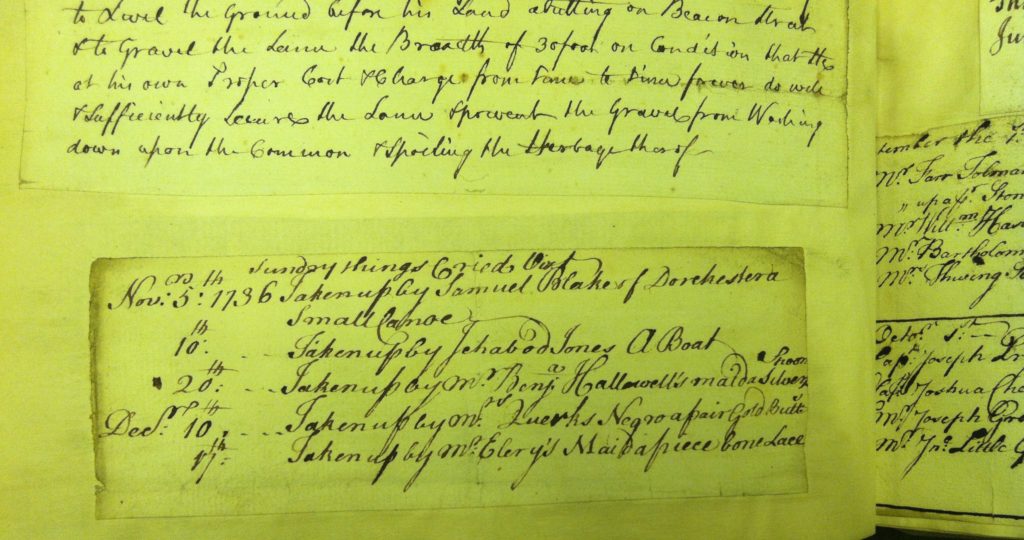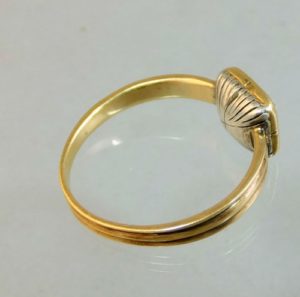What’s in a List?: Early African Americans in an Age of Consumer Revolution

As many scholars of early African American life can attest, one of the most vexing aspects of doing research is not only a lack of source material, but also the documents that do exist. Many are lists of names of free and enslaved men and women. Whether lists of enslaved people in probate inventories on southern plantations, lists of free blacks forced to work on public works in Boston, or lists of Africans aboard Atlantic slavers, we seem to have no dearth of catalogs of names. The problem is that these documents provide little, if any, context or other material for understanding the people contained within them. Nevertheless, although frustrating, historians have found useful and fruitful ways to use these documents.
Today, I want to build on this work and investigate a different type of list. A couple of years ago, I found myself in the reading room of the rare books and manuscripts division of the Boston Public Library. There, the library holds all of Boston’s early town records. Bound in large volumes and organized chronologically, I was looking for material for my book, Unfreedom. While I found some night watch records and accounts of services rendered to the town by enslaved artisans, I also came across an interesting list or, rather, many lists.
Pasted onto the pages of the nineteenth-century bound volume were eighteenth-century town crier documents kept by Arthur Hill. Hill’s records consist of lists of goods lost and found, or “taken up,” by Boston’s residents between 1736 and 1748. Required to submit these records to Boston’s selectmen, Hill seems to have had someone else keep records for a few years before taking over for himself in the early 1740s. Most importantly for our purposes here, people of African descent found a large number of the lost items recorded by Hill. Even more to the point, if we read this list in the context of both the rest of Hill’s records and eighteenth-century Boston, they provide insights into the everyday lives and lived experiences of early African Americans.

First, though, it is important to understand the function of a town crier during this period. Town criers were fixtures in early modern English towns, including those in the Americas. They would make public announcements, but also served as a sort of lost and found, collecting items people found and spreading word about items lost. Of course, this function was all for a fee. Although it started as an official, elected government position in Boston, by the time Hill became a town crier, the position had been largely privatized. As J.L. Bell describes in a series of blog posts (here, here, and here), men like Hill would apply to the selectmen for a license to be a crier. In return for permission and a promise to record all transactions, the licensee kept and recorded all the lost and found goods and charged a finders’ fee for his public announcements. That said, Hill seems exceptional in the sense that he kept such extensive records of items lost and found. His lists of goods are the only ones contained in Boston’s early town records, despite a number of criers operating during the seventeenth and eighteenth centuries.
All told, Hill’s extant records list 380 items that were lost or found. Records for goods found dwarf the items reported to Hill as lost (368 found vs. 12 lost). Let’s look at the records for goods found as it provides a much larger sample for analyzing this list. Hill made fairly meticulous notes as to who found what goods. He recorded occupation and relationships. He also recorded race, often using the term “Negro” to describe people of African descent who took up lost items. Under that or related terminology (“Negro Fellow,” etc.), Hill recorded 36 items found by black Bostonians. That would mean they found 9.8% of the total items recovered, similar to Boston’s black population during this time period, which was roughly 10-12% of the total population. Of course, there is also evidence that Hill did not always record race, such as numerous references to “Maid,” “Man,” “Servant,” or “Boy.” Without racial nomenclature, however, I will err on the side of caution and only use the 36 men and women Hill explicitly recorded as black.
Hill provides little information about these 36 individuals. Of the 36, 31 are simply listed as “Negro,” while there is one described as “Neagar,” two listed as “Negro Woman,” one as “Negro Man,” and a “Negro Fellow.” Hill did, however, provide information about their masters. Indeed, most entries describe these men and women by demonstrating ownership, such as listing one “Negro Woman” as “Capt. Alexr Sears Negro Woman.” Only one entry does not have an owner listed, suggesting the other 35 were enslaved. It is also safe to assume that 34 of the 36 were men, especially considering Hill went out of his way to record “Negro Women” in the other two entries.
If these documents do not tell us much about the biographies of these men and women, what do they explain? At the very least, Hill revealed that people of African descent had quotidian and pedestrian interactions with quasi-officials at the most intimate levels of government. They had access to and participated in local institutions, in this case reporting lost goods they found. Black Bostonians were not socially dead, but part of a vibrant world of material goods and exchange.
These lists, then, help to open up the material worlds of enslaved and free blacks in early Boston. During the eighteenth century, Boston and most other British colonies in the Americas underwent a consumer revolution. Fueled by early industrialization in England, the colonies became dumping grounds for cheap consumer products such as cloth, pottery, clothing accessories (buttons, buckles, pocketbooks, and the like), and silverware amongst many others. Colonists purchased these goods and began associating consumption to class and social status. While scholars have long studied this phenomenon for white colonials, only recently have they started to pay attention to the consumption inhabitants of people of African descent.
Hill’s lists offer a different picture and speak to enslaved and free black interactions and relationships with these material goods. Taken as a whole, the African American men and women who appear in Hill’s lists found goods that were markedly different from those reported by others. A wide range of goods appear throughout the records, but one category stands out. Of the 368 total items reported, 87 or 23.6% related to maritime activities and included naval stores, ship pieces, and, the largest in this category, small watercraft such as canoes. This trend should not come as a surprise as Boston was a bustling port city with a daily flurry of maritime activity. Other goods reported in large numbers were bulk amounts of cloth, hand tools, and livestock.

What is interesting, however, is that in the records concerning black men and women do not reflect the larger record. Only one, “Martha Grover’s Negro” found a small boat. Another found a handsaw. All of the others either found consumer goods such as gold buttons, jewelry, pocket books, and clothing items, or cash.
What accounts for this discrepancy? I believe Hill’s records show the limits of participation in the eighteenth-century consumer revolution and how dominant attitudes towards race and status confined the consumption habits of early African Americans. Take for example “Joseph Williams Negro” who found “One Gold Ring” in June 1738. Did he report his find because he was attempting to be a good community member? Perhaps. Yet, we also have to consider he told Hill about the ring because, as an enslaved black man, owning a piece of gold jewelry would have brought suspicion about where and how he acquired it, forcing him to go to Hill to protect himself and his reputation.
And then there is “Mr. Maverick shopkeeper’s Negro,” who found “a bill.” By “bill,” Hill meant paper money. Even worse than the man who found the gold ring, this man would have been doubly suspicious. First, his master was a shopkeeper, meaning if someone discovered him with money, he might be accused of stealing from his master. Second, cash, even near-worthless paper currency, was in short supply in eighteenth-century Boston, meaning his possession of such an item would immediately raise suspicions. Much like the previous example, by reporting the money to Hill, this man sought to avoid being accused of a crime he did not commit.
Of course, given Boston’s dynamic urban economy and need for labor, there would have been ample opportunity for these men to work on their own, make money, be paid in paper currency, and even save to purchase luxury goods such as jewelry. All of these are plausible and examples abound of enslaved and free black men and women engaging in these activities. Yet, Hill’s lists suggest there were suspicions of and restrictions on early black consumption. There could also be elements of coercion. Perhaps Joseph Williams forced his enslaved man to report the gold ring, hoping to avoid embarrassment or censure if the man was accused of a crime. Only other dependent people, such as servants, apprentices, and children, likewise reported large numbers of consumer goods and money to Hill—groups whose possession of those goods would have likewise aroused suspicion. Even then, they still reported the more common items at a higher rate than African Americans. In this sense, black men and women may have been part of a larger consumer revolution, but faced severe limitations on what they could and could not do and how to behave.

So, what’s in a list? In these records, can we see some of the earliest examples of consumption-based racial stereotypes and profiling? I think so. In regards to consumer goods, eighteenth-century white Bostonians treated black Bostonians differently, believing African Americans to be criminals for activities that free whites regularly engaged in. Like more contemporary examples such as Henry Louis Gates Jr. being arrested for owning a home in an upper-middle class, mostly white neighborhood in 2009 or Jamaal Wilkes being pulled over for driving a Trans-Am in 1991, the black men and women in Hill’s records faced penalties and social stigma for the most basic human behaviors—buying, selling, and using material things. Criminalized as consumers, they sought to avoid suspicion and protect themselves by approaching Arthur Hill and registering themselves on his lists.
Jared R. Hardesty is a historian of colonial America and the Atlantic World. His research investigates the contours of slavery, labor, and the nature of power in British North America. He is currently an Assistant Professor of History at Western Washington University. He is the author of Unfreedom: Slavery and Dependence in Eighteenth-Century Boston (New York University Press, 2016)
Copyright © AAIHS. May not be reprinted without permission.
What an interesting article! Thank you for exposing the time-consuming archival work involved writing history books. I will use this article in my U.S. history survey class next semester. I am sure it will be helpful to undergraduate students who are conducting research using primary sources for the first time.